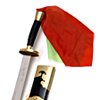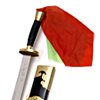|
|
|
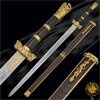 |
|
| Han Sword (SH2005) |
Points: 80
|
The Han Sword is a cavalry pattern from the Han Dynasty (206 BC - 220 AD), which reunited China and established boundaries very similar to those existing today. The rosewood grip and scabbard are inlaid with silver in an intricate scroll pattern, while the gilded steel guard, pommel and scabbard decorations feature the "crouching tiger" motif. The random pattern K120C Damascus blade, with its ridged central fuller and reinforced point is admirably suited for slashing cuts and powerful thrusts from horseback.
Recreated by the craftsmen of CAS Hanwei from the swords of the Lords of the great dynasties, these Chinese Gongfu swords represent the pinnacle of the sword maker's art, vividly illustrating the skills and creativity of the smiths of Imperial China
|
|
|
|
|
|
 |
|
| Oxtail Saber (Niu Wei Dao) Dynasty Forge (DF025) |
Points: 25

|
The Oxtail Saber was used predominantly by martial artists rather than the military, making the design difficult to attribute to a specific time period. Nevertheless, the Oxtail Saber is the most popular and recognizable of the Chinese broadswords. The Dynasty Forge Oxtail Saber is forged from 1095/1085/1060 high-carbon steel. The sheath is hand-carved from hardwood while the handle features a hardwood core wrapped in green cord. The fittings are based on an antique specimen attributed to the Qing Dynasty and have a highly stylized floral motif.
|
|
|
|
|
|
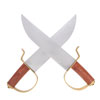 |
|
| Sword Cold Steel Butterfly Sword (88BF) |
Points: 10


|
Traditional Chinese Butterfly Swords with wide blades made by Cold Steel. Typically, Butterfly Swords come in pairs that are cleverly nested together so they appear to be one sword not two. When they are drawn, they can be quickly separated and wielded in both hands to make wickedly effective chops, slashes and thrusts.
|
|
|
|
|
|
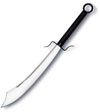 |
|
| Sword Cold Steel Chinese War Sword (88CWS) |
Points: 20

|
Few swords are more intimidating or more effective than the two handed Chinese War Sword. Its huge, wide blade will shear through armor as if it were butter, not to mention mere flesh and bones.
|
|
|
|
|
|
 |
|
| Sword Cold Steel Gim Sword (88G) |
Points: 15

|
There are two basic types of straight bladed swords used in China. One is fairly long and heavy known as the Wu Jian or "Martial Sword". The other is substantially lighter and called a Wen Jian or "Scholar's Sword" and was primarily carried for personal self defense.
|
|
|
|
|
|
 |
|
| Cold Steel Sword Jade Lion Gim (88RLG) |
Points: 35
|
The Lion Gim is a civilian self-defense Wen Jian (Scholar�s Sword), with a little more panache than the practical versions (like our own Gim Sword) that were made for the battlefield. In our tests it severed and pierced 4" bamboo poles with a single cut or thrust.
|
|
|
|
|
|
 |
|
| Cold Steel Chinese Sword Breaker (88CSB) |
Points: 15
|
Ancient Chinese Sword Breaker that can break an opponent's sword with just one blow. It's very acute point can perforate even the thickest metal armor!
|
|
|
|
|
|
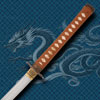 |
|
| Shogun Kiji Katana Windlass (501875) |
Points: 12


|
Handcrafted in a small town nestled in the Longquan mountains of China’s Zhejiang province, this sword embodies a 2,000-year legacy of skilled swordmaking. Every component is expertly crafted by highly skilled smiths using centuries-old methods.
|
|
|
|
|
|
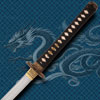 |
|
| Shogun Ryū Tatsu Katana Windlass (501874) |
Points: 12


|
The blade is forged from 1095 high carbon steel and undergoes differential clay tempering using traditional techniques. This results in a spine with a Rockwell hardness of 45-48 HRC and a harder cutting edge at 56-58 HRC. This ancient tempering method creates the distinctive hamon, the visible temper line left when the clay is removed. Each blade is meticulously honed and must cleanly slice through a sheet of paper before leaving the workshop.
|
|
|
|
|
|
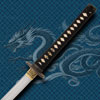 |
|
| Shogun Tsuru Katana Windlass (501873) |
Points: 12


|
The blade is forged from 1095 high carbon steel and differentially clay-tempered using traditional techniques. This results in a spine with a Rockwell hardness of 45-48 HRC and a harder cutting edge at 56-58 HRC. This ancient tempering method creates the distinctive hamon, the visible line left when the clay is removed. Each blade is meticulously honed and must cleanly slice through a sheet of paper before leaving the workshop.
|
|
|
|
|
|
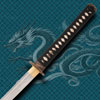 |
|
| Bushido Tonbo Katana Windlass (501876) |
Points: 15


|
The blade is pattern-welded and heat-treated to achieve a Rockwell hardness of 40-45 HRC along most of its length, with approximately 35 HRC at the guard. A simulated hamon is meticulously applied by an artisan, and each blade is honed to razor sharpness—capable of cleanly slicing through a sheet of paper before leaving the workshop.
|
|
|
|
|
|
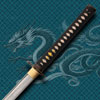 |
|
| Bushido Kiku No Gyokuza Katana Windlass (501872) |
Points: 10


|
Every part of this sword is expertly crafted by highly skilled smiths using centuries-old methods. The blade is pattern welded, with most of the blade Rockwelling in the 40-45 HRC range and about 35 HRC at the guard. The simulated hamon is expertly applied by an artisan. Each blade is honed and must be able to cleanly cut through a sheet of paper before it leaves the factory.
|
|
|
|
|
|
|
|
Tags:
swords, sword, katana, wakizashi, tanto, japanese sword, medieval sword, viking sword, japanese swords, medieval swords, viking swords, knife, knives, saber, armour, movie swords, movie replicas, martial arts, sporting goods, sporting equipment,
|







